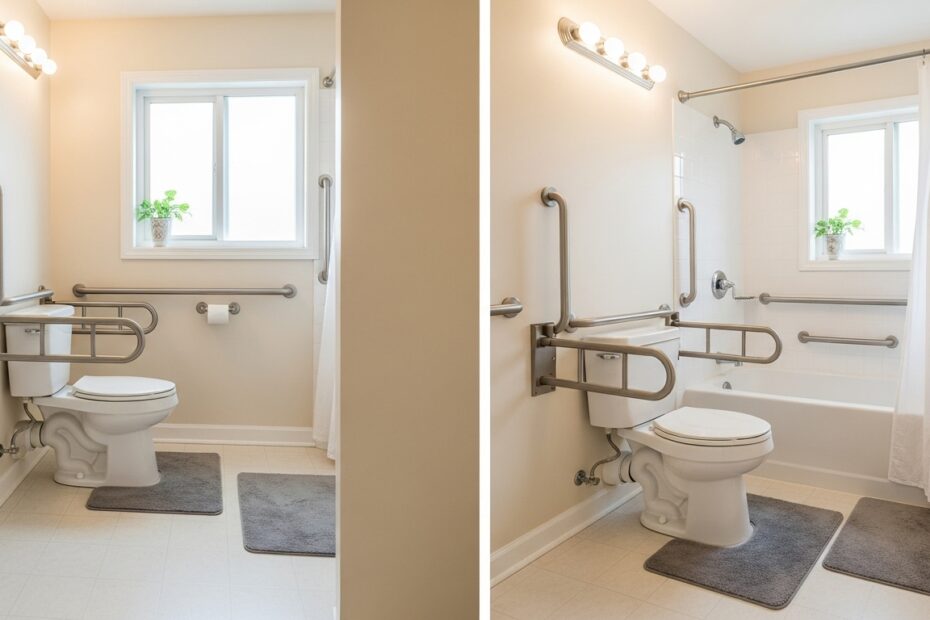As we age, the risk of falling becomes a more pressing concern, and for those over 75, this risk increases significantly. A common misconception is that falls are most likely to happen in public, on uneven sidewalks or in crowded stores. However, overwhelming evidence reveals a more startling truth: for older adults, the most dangerous place is often the one they know best.
The vast majority of falls—up to 80% of those resulting in emergency department visits—happen inside or around the home.[1] This number increases with age; adults 85 and older are even more likely to fall at home compared to their younger counterparts aged 65 to 74.[1]
Understanding exactly where these falls occur is the first step toward effective prevention. By identifying these high-risk “hotspots,” seniors and their families can make targeted modifications to create a safer living environment.
The Top 3 Fall Hotspots in the Home
While every room has potential hazards, data consistently points to three specific locations where falls are most common for older adults.[1]
1. The Bedroom (Most Common for Adults 85+)
It may seem like a safe haven, but the bedroom is a frequent site for falls, particularly for the oldest adults.[1] Falls in the bedroom often happen during the night or first thing in the morning.
- Why it’s a risk: Getting in and out of bed, especially when dizzy or stiff after sleeping, is a primary trigger.[2] Poor lighting for nighttime trips to the bathroom, clutter on the floor, and unsecured rugs create a hazardous path. For those 85 and older, a significant percentage of falls occur in the bedroom.[1]
- Prevention tips:
- Install bright, easy-to-reach lighting from the bed, and use nightlights to illuminate the path to the bathroom.
- Keep the floor clear of all clutter, including shoes, books, and electrical cords.
- Ensure the bed is at a height where feet can be placed firmly on the floor when seated on the edge.
- Remove or secure all throw rugs with non-slip backing.[3]
2. The Bathroom
The bathroom is a universally recognized danger zone due to its combination of hard surfaces and water.[4] For many seniors, this room is a site of significant fall risk.[1][2]
- Why it’s a risk: Wet, slippery floors are the most obvious hazard.[2] However, the physical actions required—stepping in and out of a tub, sitting and standing from the toilet—are challenging for those with balance issues or lower body weakness.[4]
- Prevention tips:
- Install grab bars inside the shower/tub and next to the toilet. These are essential for providing stability.[4]
- Use non-slip mats both inside the tub/shower and on the bathroom floor.
- Consider a raised toilet seat or a toilet safety frame to make sitting and standing easier.
- Ensure adequate, bright lighting.
3. The Stairs (Most Common for Adults 65-74)
Stairs represent a major hazard, especially for the “younger-old” who may still be navigating them frequently. One study found that for adults aged 65 to 74, falls on stairs were more common than in any other location at home.[1]
- Why it’s a risk: Stairs require strength, balance, and good vision—all of which can decline with age. Poor lighting can obscure steps, and carrying objects can obstruct views and throw off balance.
- Prevention tips:
- Install sturdy handrails on both sides of the staircase.[5]
- Ensure stairs are well-lit, with light switches at both the top and bottom.
- Remove any carpeting runners that are not securely tacked down.
- Never leave clutter or objects on the stairs.
Other High-Risk Areas
While the bedroom, bathroom, and stairs are the top three, other areas also pose significant risks:
- Living Rooms and Hallways: These areas account for a large percentage of falls, often due to clutter, poor lighting, and loose throw rugs.[2][6]
- Kitchens: Spills on the floor can create slick surfaces, and reaching for items in high or low cabinets can lead to a loss of balance.[6]
- Outside the Home: About 30% of falls occur in the community. For men, falls are more likely to happen outside than for women, with driveways and garages being common sites.[1][6]
By focusing on these specific, evidence-based hotspots, seniors and their families can take practical, effective steps to mitigate the risk of a fall. Modifying the home is one of the most powerful strategies for preserving independence and ensuring a safe environment for aging in place.
Join Us on Youtube – Senior Recuperate
